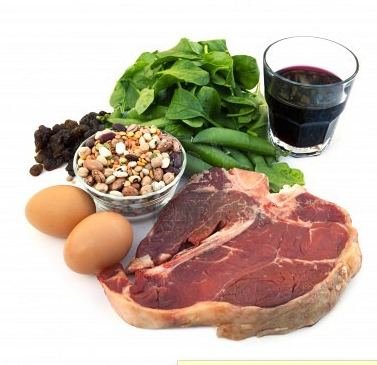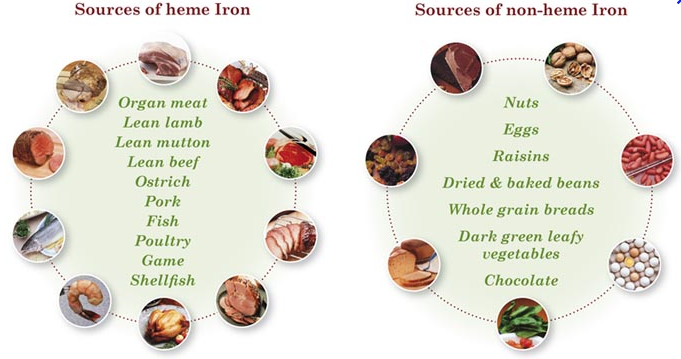Good nutrition is important for your life—not just for your athletics.
Last week, Monta Vista XC talked about nutrition before our Wednesday practice. I had several great conversations with athletes afterwards and throughout the week regarding specific nutritional concerns. These conversations had me thinking about nutrition all week long. One of my specific concerns when I think about our team: Iron.
Most of you know that iron is important to athletes, we have talked about this before: http://www.mvrunning.com/coachs/be-as-strong-as-iron/ . Fellow coaches have told me that when their young athletes, especially young female athletes, are tested, about 50% of the athletes tested are below the level that is considered optimal for endurance athletes. This is anecdotal evidence but it seems to be prevalent. A few Monta Vista runners did get their serum ferritin levels tested last summer and told me about the results, and in a VERY SMALL sample size, 50% of the athletes on our team had serum ferritin levels were below optimum for endurance athletes (but still healthy for the general population).
Please understand, NO ONE tested had unhealthy results for normal humans. No need to panic at all! However, for endurance animals like the runners on MVXC, 50% of the athletes tested had serum ferritin levels that may effect their athletic performance and recovery.
These results are consistent with what the National Institute of Health says. According to the NIH, here are the risk groups for iron depletion:
Three groups of athletes may be at greatest risk of iron depletion and deficiency:
female athletes, distance runners, and vegetarian athletes.
—Office of Dietary Supplements, National Institutes of Health, http://ods.od.nih.gov/factsheets/Iron-HealthProfessional/
Hmmm….so everyone on our team meets criteria number 2! And some of us meet all three criteria. So what should we do?
The important thing is to understand where we can get iron in our diets, and eating a wide variety of the foods that supply nutritional iron. Improving our own nutrition is the best solution to improving health and athletic performance. At the end of this web post I have attached an NIH list of some sources of iron in your food. All these foods provide other vitamins and nutrients also. How many of these foods are you eating? Can you eat more of these—maybe instead of some junk food? What do you think about throwing a bag of raisins in your track bag and having some as a part of your recovery snack after practice? If you are diligent about your diet, then you can do a lot to improve and maintain your athletic performance!
Eating better can’t hurt, and it might help! Good nutrition is a no-brainer.
Also, you should know that the way iron is absorbed varies from the source. Iron from meat sources (heme iron) is absorbed by your body almost twice as efficiently as iron from plant sources (non-heme iron) (15 to 35% of heme/meat sourced iron is absorbed vs. 2-20% of non-heme/plant sourced iron). So if you are a vegetarian, you must be especially careful to get more iron in your diet than you omnivores.
Health and nutrition is a long-term project. My understanding is that your body takes four to eight weeks after a change in your eating patterns to re-adjust iron levels. So we need to make a commitment to a life-style change, and not hope for a quick fix. Don’t expect to eat three pounds of lentils in a couple days, go back to your regular high school kid eating habits, and expect an improvement! Find habits you can live with and change your life-style, and you will change your health and your endurance.
Health professionals believe that the best way to get iron and other nutrients is directly from food. Unless you have been told by a doctor to use supplements for iron or an other vitamin or nutrient, it’s better to continue to improve your eating habits. I would prefer that no one begins use of any iron supplements without having a serum ferritin test and getting a doctor’s advice. Getting a serum ferritin test seems like a way to get some interesting and useful information for endurance athletes, and afterwards you may consult with your doctor about what you can do in the future to improve your health. I am not a doctor, I’m not your doctor, I’m just your coach and I care about you. I want everyone on our team to understand that nutrition in general, and iron in particular, is important to your health and your athletics. I would hope that everyone improves their diet to include more sources of iron. I want to see you healthy, happy and enjoying your athletic efforts!
Now, please pass the raisins!
Selected Food Sources of Heme Iron
(from the Office of Dietary Supplements, NIH)
| Food | Milligrams per serving | % DV* |
| Chicken liver, pan-fried, 3 ounces | 11.0 | 61 |
| Oysters, canned, 3 ounces | 5.7 | 32 |
| Beef liver, pan-fried, 3 ounces | 5.2 | 29 |
| Beef, chuck, blade roast, lean only, braised, 3 ounces | 3.1 | 17 |
| Turkey, dark meat, roasted, 3 ounces | 2.0 | 11 |
| Beef, ground, 85% lean, patty, broiled, 3 ounces | 2.2 | 12 |
| Beef, top sirloin, steak, lean only, broiled, 3 ounces | 1.6 | 9 |
| Tuna, light, canned in water, 3 ounces | 1.3 | 7 |
| Turkey, light meat, roasted, 3 ounces | 1.1 | 6 |
| Chicken, dark meat, meat only, roasted, 3 ounces | 1.1 | 6 |
| Chicken, light meat, meat only, roasted, 3 ounces | 0.9 | 5 |
| Tuna, fresh, yellowfin, cooked, dry heat, 3 ounces | 0.8 | 4 |
| Crab, Alaskan king, cooked, moist heat, 3 ounces | 0.7 | 4 |
| Pork, loin chop, broiled, 3 ounces | 0.7 | 4 |
| Shrimp, mixed species, cooked, moist heat, 4 large | 0.3 | 2 |
| Halibut, cooked, dry heat, 3 ounces | 0.2 | 1 |
Selected Food Sources of Nonheme Iron
(from the Office of Dietary Supplements, NIH)
| Food | Milligrams per serving | % DV* |
| Ready-to-eat cereal, 100% iron fortified, ¾ cup | 18.0 | 100 |
| Oatmeal, instant, fortified, prepared with water, 1 packet | 11.0 | 61 |
| Soybeans, mature, boiled, 1 cup | 8.8 | 48 |
| Lentils, boiled, 1 cup | 6.6 | 37 |
| Beans, kidney, mature, boiled, 1 cup | 5.2 | 29 |
| Beans, lima, large, mature, boiled, 1 cup | 4.5 | 25 |
| Ready-to-eat cereal, 25% iron fortified, ¾ cup | 4.5 | 25 |
| Blackeye peas, (cowpeas), mature, boiled, 1 cup | 4.3 | 24 |
| Beans, navy, mature, boiled, 1 cup | 4.3 | 24 |
| Beans, black, mature, boiled, 1 cup | 3.6 | 20 |
| Beans, pinto, mature, boiled, 1 cup | 3.6 | 21 |
| Tofu, raw, firm, ½ cup | 3.4 | 19 |
| Spinach, fresh, boiled, drained, ½ cup | 3.2 | 18 |
| Spinach, canned, drained solids ½ cup | 2.5 | 14 |
| Spinach, frozen, chopped or leaf, boiled ½ cup | 1.9 | 11 |
| Raisins, seedless, packed, ½ cup | 1.6 | 9 |
| Grits, white, enriched, quick, prepared with water, 1 cup | 1.5 | 8 |
| Molasses, 1 tablespoon | 0.9 | 5 |
| Bread, white, commercially prepared, 1 slice | 0.9 | 5 |
| Bread, whole-wheat, commercially prepared, 1 slice | 0.7 | 4 |
*DV = Daily Value. DVs are reference numbers developed by the Food and Drug Administration (FDA) to help consumers determine if a food contains a lot or a little of a specific nutrient. The FDA requires all food labels to include the percent DV (%DV) for iron. The percent DV tells you what percent of the DV is provided in one serving. The DV for iron is 18 milligrams (mg). A food providing 5% of the DV or less is a low source while a food that provides 10–19% of the DV is a good source. A food that provides 20% or more of the DV is high in that nutrient. It is important to remember that foods that provide lower percentages of the DV also contribute to a healthful diet. For foods not listed in this table, please refer to the U.S. Department of Agriculture’s Nutrient Database Web site.


